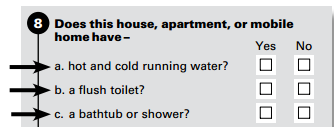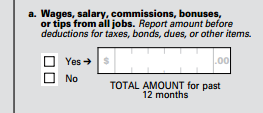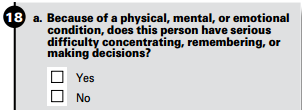The U.S. Census Bureau is considering whether to drop some questions that it has used for decades from its largest household survey of Americans. First under review are four of the touchiest topics: Plumbing, commuting, income and disability.
 The questions being rethought number more than a dozen that fall under those four topics, including: Does your house have a flush toilet? What time did you usually leave home to go to work last week? What was your total income during the past 12 months? Do you have trouble concentrating, remembering or making decisions because of a physical, mental and emotional condition?
The questions being rethought number more than a dozen that fall under those four topics, including: Does your house have a flush toilet? What time did you usually leave home to go to work last week? What was your total income during the past 12 months? Do you have trouble concentrating, remembering or making decisions because of a physical, mental and emotional condition?
Three million households a year are asked these questions—and dozens of others—on the bureau’s American Community Survey. The survey’s annually updated data help guide the distribution of more than $416 billion in federal funds. Its data provide demographic, social, economic and housing estimates that are widely used by state and local officials, businesses, researchers and advocacy organizations. It is the only source of local and neighborhood-level data on these topics.
But some Americans who receive the survey are so angry about these questions and others that they complain to members of Congress.They say that they will refuse to answer, even though response is mandatory. They believe some questions are too nosy, or that the bureau should not collect more than basic data, or both. Some call their local TV station to ask whether the survey is a scam.
Bureau officials counter that federal law protects the privacy of individual responses, and have posted a guide to why specific questions are asked. The agency and its supporters in Congress note that every question on the survey is required by a federal law, regulation or program and the courts have upheld the government’s right to ask these questions.
The Census Bureau’s audit of the American Community Survey, called “content review,” begins with the four topic areas and eventually will cover all questions on the survey. It is a different exercise from the agency’s review and rewording of health-insurance questions on the Current Population Survey, which drew controversy last week.
Speaking this month at a webinar for data users, Census Bureau official Gary Chappell said the agency receives “a lot of feedback”—up to a hundred letters a year—on some topics. The American Community Survey’s predecessor, the decennial census long form, also was the object of protests, which were concentrated in the months when the census was being taken. Bureau officials say the protests make it harder for the bureau to collect information, and may weaken data quality if respondents leave items blank.
Here is a look at four of the questions under review, with an explanation of how the data are used. The most frequent complaints are that the questions are unwarranted intrusions on personal privacy, that they are overly burdensome or that the government already collects the information elsewhere, such as through the Internal Revenue Service.
- Does this house, apartment or mobile home have a flush toilet?
 How it’s used: Plumbing data are used by federal agencies to allocate federal housing subsidies, identify poor-quality housing and identify candidates for home repair or other assistance. The data also help public health officials identify areas with potential ground water contamination or waterborne diseases. The plumbing questions were first asked on the 1940 Census. Chappell acknowledged that the plumbing questions may have been more useful in earlier eras, when more homes lacked basic sanitation facilities. However, these estimates may still be important in some rural areas and on American Indian lands.
How it’s used: Plumbing data are used by federal agencies to allocate federal housing subsidies, identify poor-quality housing and identify candidates for home repair or other assistance. The data also help public health officials identify areas with potential ground water contamination or waterborne diseases. The plumbing questions were first asked on the 1940 Census. Chappell acknowledged that the plumbing questions may have been more useful in earlier eras, when more homes lacked basic sanitation facilities. However, these estimates may still be important in some rural areas and on American Indian lands.
- What time did [each person in the household] usually leave home to go to work last week?
 How it’s used: Commuting data in general are used to plan road and public-transit improvements, and to design energy-conservation programs. Knowing when people leave for work can be used to plan programs to reduce traffic problems during peak hours. The aggregated numbers are widely used not only by the federal government, but also by local and regional planning agencies. Data about commuting (“journey to work,” in census parlance) has been collected for more than five decades.
How it’s used: Commuting data in general are used to plan road and public-transit improvements, and to design energy-conservation programs. Knowing when people leave for work can be used to plan programs to reduce traffic problems during peak hours. The aggregated numbers are widely used not only by the federal government, but also by local and regional planning agencies. Data about commuting (“journey to work,” in census parlance) has been collected for more than five decades.
- What was [each person in the household’s] total income during the past 12 months?
 How it’s used: Income data are used by federal programs to allocate funds for health care, food or other assistance to low-income areas or populations, and to target communities for economic improvement programs. The survey’s income estimates are widely used by governments, researchers and others. Privacy restrictions prevent the bureau from matching IRS data with census data. (The Canadian census first offered respondents the option in 2006 to grant permission to use their tax records as the source of their income data; 82% said yes.)
How it’s used: Income data are used by federal programs to allocate funds for health care, food or other assistance to low-income areas or populations, and to target communities for economic improvement programs. The survey’s income estimates are widely used by governments, researchers and others. Privacy restrictions prevent the bureau from matching IRS data with census data. (The Canadian census first offered respondents the option in 2006 to grant permission to use their tax records as the source of their income data; 82% said yes.)
- Because of a physical, mental or emotional condition, does [each] person have serious difficulty concentrating, remembering, or making decisions?
 How it’s used: The question is among six asking about specific types of disabilities, based on standards from the Institute of Medicine. The answers are used by various federal programs to assess the need for services for the disabled, such as transportation, employment and health care. The current questions have been asked on the American Community Survey since 2008, though in the modern era other questions on disability have been asked since 1970.
How it’s used: The question is among six asking about specific types of disabilities, based on standards from the Institute of Medicine. The answers are used by various federal programs to assess the need for services for the disabled, such as transportation, employment and health care. The current questions have been asked on the American Community Survey since 2008, though in the modern era other questions on disability have been asked since 1970.
The bureau’s rethinking of its questions is part of an extensive examination of the survey’s methods and management that began in 2010, five years after it began publishing national estimates. Last year, the bureau announced that it had appointed a new “respondent advocate,” whose job is to “help make the Census Bureau more aware and more sensitive to the concerns of our household respondents.” The agency also is researching ways to reduce aggressive attempts to reach respondents who do not answer the survey, which have been another source of complaints.
The “content review” project is coordinated with the Office of Management and Budget, which must approve questions asked on federal surveys. Census officials plan to survey federal agencies, survey respondents and data users about whether the usefulness and quality of the data obtained from the questions outweighs the difficulty of collecting good information.
Federal officials plan to announce decisions late this year on whether to keep, drop or suggest modifications in the four topic areas. Any changes to the American Community Survey would be implemented by 2016.
Note: This post originally stated that Census data help guide the distribution of $416 million in federal funds. It is $416 billion.



